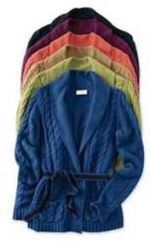Care of Sweaters
Each year there comes the joyous season when there begins to be a chill in the air. This is a favorite time for many. It is the winter season where we get to pull out our sweaters and enjoy their warmth.
Although sweaters give us much warmth and joy, at times they can be a challenge to care for. Different types of sweater fabric require different types of care and special attention.
The most important step in caring for a sweater is to read the sweaters tag and follow those directions exactly. If the tag says “dry clean ONLY” then it is best to have it dry cleaned. However, if it says “dry clean” then the sweater may be hand washed.
Washing
Washing a sweater is important, however it is also important to remember to avoid over washing the sweater. Because most sweaters are worn over other clothing they don’t typically get soiled as quickly as clothing next to the body does. Spots can be treated without washing the entire sweater. Over washing loosens the fibers in the fabric causing the sweater to lose its shape.
When washing a sweater do not throw it into the laundry bin with all your other clothes. It may get snagged on other clothing or accidentally get put in the wrong cycle. Place your sweaters in a pillow case or a special mesh bag, called a Sweater Laundry Wash Bag. This bag insures that sweaters don’t snag on any other clothing in the washer or on any parts of the washing machine. You may also use a Lingerie bag which is similar to a wash bag. These bags may be purchased online at many locations. The recommended sites are organize.com, spacesavers.com, and walmart.com.
When washing the sweater it is important to use a safe detergent for the fabric. Much like human hair wool sweaters and other sweaters made of animal hair are very sensitive. It would not be realistic to use laundry detergent on your own hair and many times it isn’t realistic to use laundry detergent on your sweaters. There are various kinds of mild detergents that may be used to wash sweaters. You will want a detergent without alkaline pH. Dish washing detergents and shampoos are usually base, so these are good to use to wash sweaters. Ecover is natural detergent company that makes detergent especially for wools and fine fabrics.
It is best to wash sweaters in a plastic tub rather than in a sink. Often times sinks have left over soap residue that my harm the sweater. Fill the plastic tub with lukewarm water add the detergent and then the sweater. Let the sweater soak for about 20 minutes. This allows the detergent to penetrate the fabric. Swirl the fabric in the water do not wring it or rub it. Let the water run over it to rinse it.
If you choose to machine wash your sweater, only do so on the delicate cycle and in a laundry wash bag. A hint to keeping your sweaters softer and fluffier is to add a couple of capfuls of distilled white vinegar in the rinse cycle.
Drying
To dry the sweater lay it onto a light colored towel and then role the towel up and squeeze the towel to remove
excess water from the sweater. Unroll the towel and place the sweater on a sweater drying rack (or use a window screen to dry the sweater). A tip to blocking the sweater, or shaping the sweater, is to lay the sweater on the drying rack before it is washed and tape an outline of the sweater on the rack. After it is washed you may lay the sweater on the rack and shape the sweater until it reaches its original size. The window screen should be placed between two chairs so that the air may dry the sweater from both sides. Place a towel underneath the sweater on the floor or over the tub to catch excess water. Allow for the sweater to completely dry before storing.
Ironing
Many sweaters should not be ironed. A good way to get the wrinkles out is to let it sit in a steamy bathroom. If the sweater does allow for ironing it should be turned inside out and another piece of fabric should be placed over it before ironing it on a low setting.
Storing
A sweater should never be hung up on a hanger. The weight of the sweater will pull on it and pull it out of shape. It is best to gently fold them. Place them in an area with plenty of space. Never stuff them in crowded drawers. When storing sweaters for the summer season wash them before storing and allow them to completely dry before storing them. If sweaters are damp mildew and mold will grow and it is impossible to remove.
Buy plastic storage containers to store your clothing. This is preferred over cardboard boxes because cardboard my allow insects and mice in more easily. Don’t store your sweaters in plastic bags because they don’t allow the clothing to breathe enough. Also buy acid free tissue paper to wrap your sweaters in. When placing the sweaters in the bins put the lightest items on top and the heaviest items on bottom. Stack the sweaters loosely so that air can circulate through them. Make sure that the area you store them in is clean, dry, dark, and cool.
To prevent moths from getting to your sweaters it is best not to use mothballs; they smell bad and contain harmful chemicals. It is better to use cedar blocks or herbal satchels. There are also a variety of sprays that may be used to prevent moths. Clothes moths are dark the lighter moths are more prone to hangout around the pantry.
Maintenance
Often times sweaters will develop pilling. To remove this fuzz you can purchase a sweater shaver that removes lint pills from sweaters. These may be purchased at Target, Wal-Mart, or Bed Bath & Beyond. Another way to remove the pills is to use a firm toothbrush. This may take a little longer but it works. Lay the sweater on a flat surface and hold it tight with one hand. Use a brisk but gentle stroke to remove the pilling. To remove hair, dandruff, lint or other objects on the sweater use a child’s hairbrush. If your sweater gets a snag never cut it or pull on it. Gently pull it back to the inside with a crochet hook.
___________________________________________________________________________________
To get more information on sweaters or other consumer solutions, call USU Extension/Weber County at (801) 399-8200 or go online at www.extension.usu.edu/weber.















Add comment